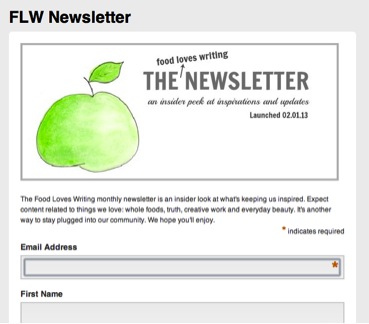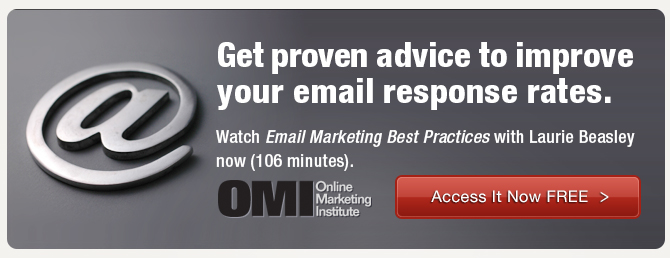 Are your email response rates dropping? Are your open rates getting worrisome? If you're feeling discouraged, don’t be. The good news is there are steps you can take to improve your open rates. Here are ten tips to try:
Are your email response rates dropping? Are your open rates getting worrisome? If you're feeling discouraged, don’t be. The good news is there are steps you can take to improve your open rates. Here are ten tips to try:
1. Set the Right Expectations
Nothing will harm your email marketing open rates faster than failing to deliver what you promised. If you tell your blog readers that your email newsletter will provide behind-the-scenes info, then behind-the-scenes info better be what you give. This is what they’ll be expecting, and this is why they agreed to subscribe in the first place. Use your site's Subscribe page to clearly explain what your newsletters offer. This way, the people who sign up will be interested in what you provide, and thus they’ll be more likely to click through to the emails that come.
2. Make Your Subject Line Short
Ideally, your email subject line should be short—easy enough to be read at a glance. Different email providers will display different lengths of text, so longer subject lines have a higher chance of being cut off. To ensure the greatest number of readers see your subject, aim to keep it under 50 characters or so.
3. Make Your Subject Line Intriguing
Assuming you have an engaged audience that is interested in what you have to say, the next best step to achieving better response rates is good subject lines. The subject line is what appears in a recipient’s inbox, inviting him or her to click. It gets a few seconds of attention before being opened or deleted. So that’s why the best subject lines offer something of value, for minimum risk. They give the recipient a sense that clicking through to the actual email newsletter will deliver something worthwhile. What are some examples of intriguing newsletter titles? To put it simply, readers like subject lines that identify your brand, hint at the content inside, and have something to offer them. For readers who want to stay updated with your company, for example, consider the following examples, written for the (fictional) company Good Deals:
- October Update on Good Deals
- Good Deals October 2013 Newsletter
- Good Deals Newsletter #15: October 2013 Edition
- Good Deals Invites You to Our Grand Opening!
- Upcoming Events at Good Deals
- Good Deals Fall Updates
- 20% Off Good Deals Merchandise Now
In every example, the subject line tells the reader what the email is about, identifies the content as from Good Deals, and gives a reason to click.
4. Don’t Be Overly Promotional
According to Ginny Soskey at Hubspot, it’s a good idea to balance your newsletter content to be 90% educational and 10% promotional. This means that, sure, you want to tell your audience about your new product or feature, but don’t let that be all you do. Your newsletter should be more than a sales brochure—it should be an interesting resource. Ask yourself what you can give your readers beyond a catalog, and work that into your content. RELATED CLASS: How to Writer Killer Email Copy
5. Send It at the Best Time
You know what they say: “Timing is everything.” The timing of when you send your newsletter may affect how readers respond to it. Test different schedules to see how your audience responds—while this may differ for various industries, according to the Whole Whale blog, there is evidence that “weekdays outperform weekends, with Tuesday-Thursdays performing the best.”
6. Be Honest about Email Content
Just like your Subscribe page should accurately describe your email content, so should your newsletter subject line. If a reader clicks the “Big Company News October 2013” email only to find a story from last month, he or she might not click through the next month’s letter. Or worse, he or she might unsubscribe.
7. Avoid Spam Signals Like ALL CAPS and Exclamation Marks!!!
Everybody’s got spam radar these days. Who hasn’t received an email from an overseas prince asking for money? Because of this, readers are more cynical—and this means they’re looking at your email newsletter with caution, at least the first time they see it. To help build credibility and keep yourself from looking like a spammer, avoid spam giveaways like writing in all capital letters or using multiple exclamation marks.
8. Avoid Salesy Language
Words like “exciting,” “leading,” and “ultimate” tend to sound salesy. Readers see them and think advertising. So to keep from getting deleted, make your subject lines benefit-driven rather than sales-focused.
9. Consider a Negative Subject Line
“People will always work harder to keep something they have rather than try to gain something that they want,” says Sean Platt at Copyblogger. That’s why negative headlines can be so powerful—they alert your readers to potential problems they could protect themselves against. Here are a few examples:
- Five Reasons You Won’t Want to Miss This Weekend Sale
- Good Deals Update: Are You Making These Shopping Mistakes?
- 4 Things You Might Be Missing on Our New Blog
10. Optimize for Mobile Devices
A large percentage of your readers will receive your email newsletter while they’re on their mobile devices. Consider how your email newsletter will appear on a mobile device. Before sending it out to your entire list, send a test version to your own email. Check for display problems, broken links, and so on.
Your Thoughts
What do you think? Do you want to increase your reader response rates? If so, why not try the above ideas to see how your rates improve?
Learn how to drive more email opens, clicks, and conversions.
Watch Email Marketing Best Practices now, and discover advanced tips to make your email marketing more effective. From creative and offer to list building and timing, this class covers what you need to know to take your email marketing to the next level. Get instant access now—FREE.

